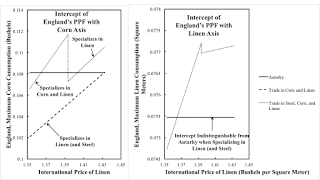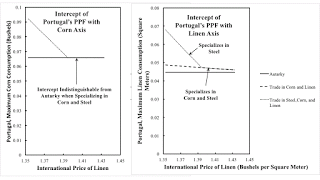Figure 1: Intercepts of Production Possibilities Frontiers for England1.0 Introduction In this example, gains and losses from trade vary with international prices. Given rates of profits are compatible with an interval of relative international prices for linen and corn, when trade exists only in consumer goods. I explore whether, when trade exists in capital and consumer goods, more than one pattern of specialization among countries is possible, depending on relative international prices. I am beginning to think that specialization, in this model, in corn and linen is infeasible, except in knife-edge cases. The theory of comparative advantage provides no valid justification for the abolition or the lowering of tariffs. Unregulated international trade is not about efficient use of
Topics:
Robert Vienneau considers the following as important: Example in Mathematical Economics, international trade, paul krugman
This could be interesting, too:
Robert Vienneau writes Austrian Capital Theory And Triple-Switching In The Corn-Tractor Model
Robert Vienneau writes Double Fluke Cases For Triple-Switching In The Corn-Tractor Model
Robert Vienneau writes The Emergence of Triple Switching and the Rarity of Reswitching Explained
Robert Vienneau writes Recap For A Triple -Switching Example

|
| Figure 1: Intercepts of Production Possibilities Frontiers for England |
In this example, gains and losses from trade vary with international prices. Given rates of profits are compatible with an interval of relative international prices for linen and corn, when trade exists only in consumer goods. I explore whether, when trade exists in capital and consumer goods, more than one pattern of specialization among countries is possible, depending on relative international prices. I am beginning to think that specialization, in this model, in corn and linen is infeasible, except in knife-edge cases.
The theory of comparative advantage provides no valid justification for the abolition or the lowering of tariffs. Unregulated international trade is not about efficient use of an international allocation of resources. Many existing textbooks, including Krugman and Obstfeld's, should be ripped up, and the authors should start again.
2.0 Technology, Endowments, And The Rate Of ProfitsI assume each of two countries (Tables 1 and 2) have a fixed-coefficients technology for producing three commodities. The technology varies between countries, although it has the same structure in both. Steel is the only capital good. Each commodity can be produced, in a year, from inputs of labor and steel. A coefficient of production shows the quantity of an input needed per unit output. For example, in England, one person-year and 1/30 tons of steel must be purchased per square meter of produced linen. Steel is totally used up in production, and constant returns to scale obtains.
| Inputs | Industry | ||
| Steel | Corn | Linen | |
| Labor | a0, 1(E) = 1 | a0, 2(E) = 8 | a0, 3(E) = 12 |
| Steel | a1, 1(E) = 1/5 | a1, 2(E) = 1 | a1, 3(E) = 1 |
| Inputs | Industry | ||
| Steel | Corn | Linen | |
| Labor | a0, 1(P) = 6/5 | a0, 2(P) = 12 | a0, 3(P) = 20 |
| Steel | a1, 1(P) = 1/4 | a1, 2(P) = 2 | a1, 3(P) = 3/2 |
I take endowments of labor as given, as in the Ricardian model of foreign trade. Let England and Portugal both have available a labor force consisting of one person-year. So Production Possibilities Frontiers (PPFs) are found per person-year. By assumption, workers neither immigrate nor emigrate. In this model, full employment is assumed.
I also take the rate of profits as given, at 100 per cent in England and at 20 percent in Portugal. I assume that financial capital cannot flow between countries. So the rate of profits need not be the same across countries.
3.0 SummaryI apply my usual analysis to determine patterns of specialization, given technology, endowments, and rates of profits in each country. When foreign trade is possible in corn and linen, but not steel, the domestic price of steel and the wage in each country must be such that the going rate of profit is earned in producing steel. Likewise, firms in, say, England make neither extra profits nor incur extra costs in producing the consumer good in which England specializes. The firms would incur extra costs if they were to produce the other consumer good. The same principles extend to the case in which foreign trade is possible in all produced commodities.
In this analysis, which is an example of a small country model, prices for goods bought or sold in foreign trade are taken as given by firms in all countries. I find prices and specializations which are consistent with the given parameters. One can draw Production Possibility Frontiers (PPFs) for each country, given prices in foreign markets and specializations. A PPF shows possible baskets of consumer goods when labor is fully employed. In this model, each PPF is a decreasing function in the first sector of the two-dimensional space formed by quantities of corn and linen. Such a PPF is fully specified by the intercepts. The intercept with the corn axis is maximum amount of corn that can be consumer, per employed worker, given that no linen is consumed. Similarly, the intercept with the linen axis is the maximum amount of linen that can be consumed. Figure 1, above, and Figure 2, show the intercepts for the PPFs for England and Portugal, respectively.

|
| Figure 2: Intercepts of PPFs for Portugal |
In the example:
- When foreign markets exist only for corn and linen:
- England specializes in the production of linen (and steel), while Portugal specializes in corn (and steel).
- England suffers a loss from trade, except when the international relative price of linen is at its highest feasible level.
- Portugal obtains a gain from trade.
- England’s loss and Portugal’s gain is smaller for larger relative prices of linen on international markets.
- When foreign markets exist for steel, corn, and linen:
- For a relatively small ratio of the international price of linen to the international price of corn, England specializes in corn and linen, and Portugal specializes in steel.
- In this range, prices compatible with England specializing in linen and Portugal specializing in steel and corn provide England with extra profits in producing corn.
- This case is infeasible. England only obtains steel by trading corn for it. England is unwilling to trade linen for steel, and Portugal is unable to acquire linen by selling steel.
- For a relatively large ratio of the international price of linen to the international price of corn, England specializes in linen, and Portugal specializes in steel and corn.
- In this range, prices compatible with England specializing in corn and linen and Portugal specializing in steel provide Portugal with extra profits in producing corn.
- England obtains a gain from trade, as compared to when foreign trade is only possible in consumer goods
- For a low price of linen in this range and a consumer basket heavily weighted to corn, England suffers a loss from trade, as compared to autarky.
- Otherwise, England obtains a gain from trade, as compared to autarky.
- Portugal’s PPF is identical to what it would be if foreign trade were possible only in consumer goods.
- Accordingly, Portugal obtains a gain from trade, as compared to autarky.
 Heterodox
Heterodox
